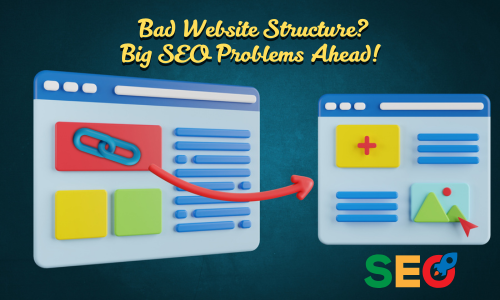You’ve probably poured hours, days, or even weeks into nailing down the perfect keywords and crafting solid content. But if your site still isn’t hitting the top ranks, your website’s structure might be the one to blame.
A poor site layout can seriously mess with your SEO efforts. It’s harder for search engines to crawl and understand your pages.
Think of it like a messy store: if shoppers (and Google) can’t find what they’re looking for easily, they’re more likely to leave frustrated. In this article, we’ll dive into how a clunky structure can hold your SEO back and what you can do to fix it.
Confusing Navigation Hurts User Experience (and SEO)
When visitors land on your site, they should be able to find what they’re looking for quickly. If your navigation is confusing (think of too many menu items, buried pages, or unclear labels), users get frustrated and leave.
This affects your SEO because search engines notice when visitors don’t stick around, signaling that your site might not be giving people what they want.
Google’s crawlers rely on clear, logical navigation to understand your site’s layout. A streamlined, user-friendly menu makes it easier for both people and search engines to navigate, boosting your SEO in the process.
Poor URL Structure Confuses Search Engines
Your URLs should give search engines (and users) a clear idea of what each page is about. If your URLs are long, packed with random numbers, or don’t follow a logical pattern, search engines can struggle to understand how your pages relate to each other.
When even search engines struggle, let alone your readers. This way, your SEO can be negatively affected, as it’s harder for search engines to prioritize and rank your content correctly.
A clean, descriptive URL structure (for example: “/products/mens-shirts” instead of “/prod1234”) helps search engines recognize your site’s hierarchy. It makes it much easier for search engines to crawl and categorize, which can lead to better rankings.
Lack of Internal Linking Disrupts Site Flow
Internal links are like a roadmap guiding both users and search engines through your website.
When pages aren’t well-linked, visitors might struggle to find related content, and search engines may miss key pages altogether. This disrupts the natural flow of your site, which can prevent search engines from fully understanding and indexing your content.
Strategically linking related pages will help you inform search engines to map out your site’s structure and highlight important content– which can improve your SEO. Internal links can also encourage visitors to spend more time on your site. Once you do this, you will reduce bounce rates and will likely give your rankings a boost.
Too Many Duplicate Pages Dilute SEO Value
Duplicate pages can confuse search engines and hurt your SEO by spreading ranking potential across multiple versions of the same content.
If your site has duplicate pages (whether from similar product listings, identical content under different URLs, or multiple versions of a page for different devices), search engines don’t know which version to prioritize.
When there are too many choices, your rankings get weaker since your SEO value is split across duplicates.
So, make sure you consolidate duplicate pages or use canonical tags to indicate the primary version. This way, you help search engines focus on ranking one strong page instead of competing versions, which can lead to better visibility and rankings.
Slow Loading Times Drive Visitors Away
Poorly structured websites are more likely to have slower loading times. A slow-loading website not only frustrates visitors but also signals to search engines that your site may not offer the best user experience.
Search engines prioritize fast, responsive sites because they want to deliver the best results for users. That’s why when pages take too long to load, visitors are more likely to leave, increasing your bounce rate– which can hurt your SEO.
To help you speed up your website loading time, you need to optimize images and videos, reduce unnecessary scripts, and use caching. You can use Google’s PageSpeed Insights to check your website’s loading speed.
If you embed a video on the homepage, like DPS Power, make sure you compress it for faster loading and use lazy loading to delay playback until it's visible on the screen.
Wrapping Up: Build a Site That Works for You, Not Against You
Your website’s structure is the foundation of a strong online presence. By investing time in a clear, organized layout, you’re setting up your site for long-term SEO success.
A well-structured website not only helps search engines understand your content but also creates a seamless experience for visitors. They are more likely to stay, explore, and engage.
So, ready to take your site to the next level? Start building a structure that supports your goals and watch your overall SEO efforts thrive.





Tiap hari memang belajar untuk buat blog semakin bagus di mata seo yaaa. Banyak nih homework saya setelah baca ini. 😅. Pelan2 semoga apa yg ditulis di blog, bisa terhitung bagus di mata seo . Nak juga perbaiki 1-2 points
BalasPadamFuhh..mencabar nak belajar structure SEO ni. Tambah lagi google yang sering berubah algorithm. Terima kasih untuk perkongsiannya.
BalasPadamTerima kasih kerana singgah ke Blog Sii Nurul. Jika ada sebarang pertanyaan, komen, penambahbaikan, cadangan mahupun pandangan. Boleh tinggalkan jejak anda.